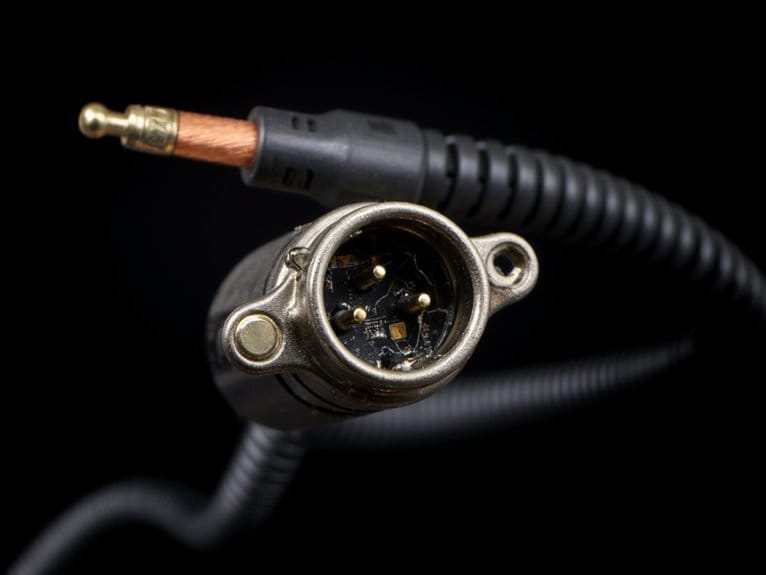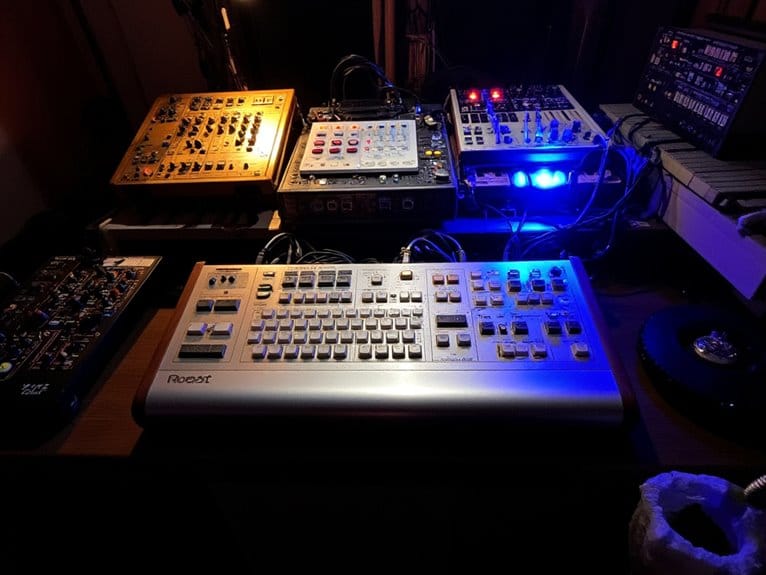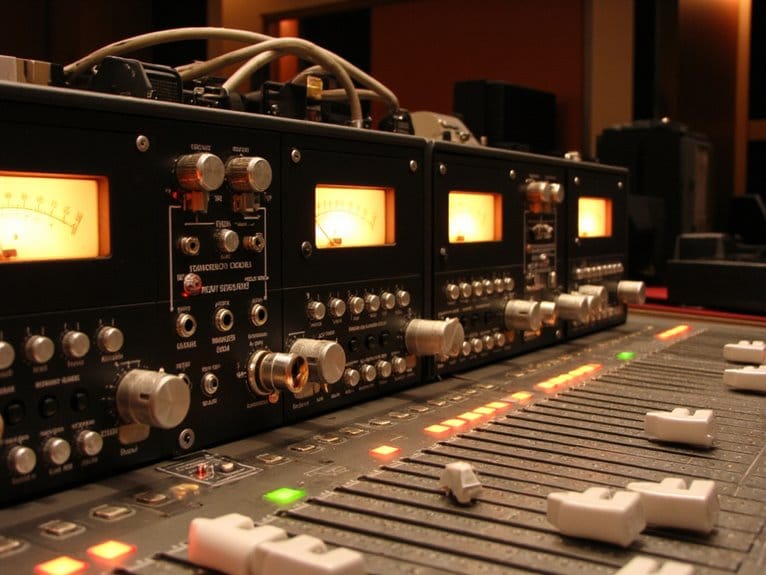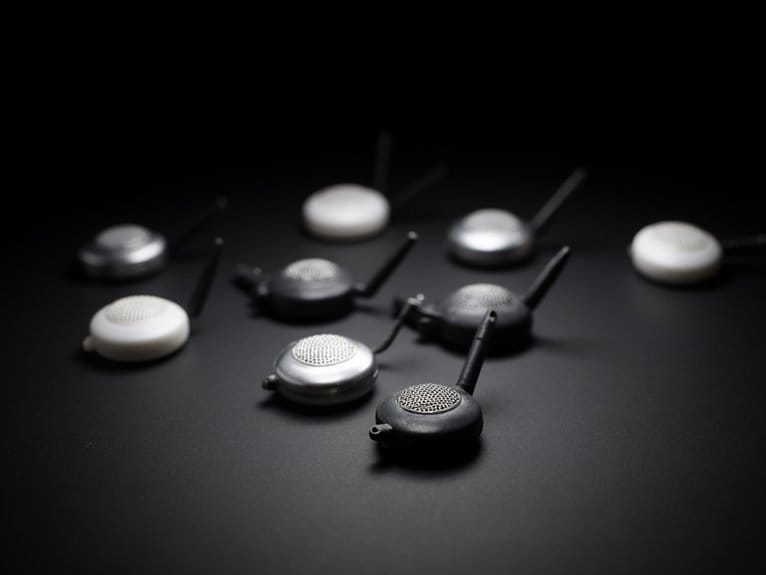Understanding Microphone Impedance and Matching
You’ll need to understand that microphone impedance, measured in ohms, determines how effectively your audio signal travels from mic to preamp without degradation. Low-impedance mics (150-600 ohms) offer professional performance with excellent noise immunity, while high-impedance models exceed 10,000 ohms but suffer from interference issues. Your preamp’s input impedance should ideally be ten times your microphone’s output impedance to maintain signal strength and prevent frequency response problems that can compromise your recordings’ clarity and tonal balance through proper equipment selection.
We are supported by our audience. When you purchase through links on our site, we may earn an affiliate commission, at no extra cost for you. Learn more.
Notable Insights
- Microphone impedance, measured in ohms, determines how audio signals travel from microphones to recording equipment and affects overall sound quality.
- Low impedance microphones (150-600 ohms) provide superior performance and noise immunity, while high impedance models suffer from interference and signal loss.
- Proper impedance matching follows a 1:10 ratio guideline, where preamp input impedance should be ten times the microphone’s output impedance.
- Mismatched impedances cause frequency response shifts, signal loss, and require increased gain that introduces unwanted noise and distortion to recordings.
- Different microphone types require specific impedance ratios: dynamic mics need 1:5 to 1:10, condensers need 1:10 or higher, and ribbons need minimum 1:10.
What Is Microphone Impedance and How Is It Measured
When you’re working with microphones, understanding impedance becomes essential because it directly affects how well your audio signal travels from the mic to your recording equipment.
Frankly, it’s one of those technical concepts that can make or break your sound quality. Impedance, measured in ohms, represents the opposition your microphone presents to alternating current, and it’s determined by the electrical characteristics of the capsule and internal circuitry.
Getting microphone impedance wrong can absolutely destroy your audio quality before you even hit record.
These microphone characteristics vary with frequency due to capacitive and inductive elements responding differently across the audio spectrum. Microphones possess low output impedance for signal integrity over long cables. You’ll find this impedance rating listed on the microphone itself or in the manufacturer’s manuals.
Professional measurement techniques involve applying AC signals at various frequencies while recording voltage and current values, typically using impedance bridges or audio analyzers that sweep across relevant frequency ranges to create thorough impedance curves.
Low, Medium, and High Impedance Categories Explained
Low impedance microphones, ranging from 150-600 ohms, deliver superior dynamic range and professional-grade performance with excellent noise immunity over long cable runs.
Medium impedance mics, spanning 600-10,000 ohms, offer compromised solutions requiring careful impedance balancing with your equipment.
High impedance microphones, exceeding 10,000 ohms, typically found in budget gear, suffer from interference susceptibility and weak signal output that limits cable lengths. The ideal preamp input impedance should be about ten times the microphone’s output impedance to achieve optimal performance and signal transfer.
Transformer-coupled microphones provide balanced output which significantly enhances signal quality and reduces common-mode noise interference.
Understanding these distinctions helps you choose appropriate equipment and avoid the frustrating signal degradation issues I’ve witnessed countless times.
How Impedance Affects Audio Signal Quality and Transmission
When you’re recording with different microphone impedances, you’ll quickly discover that the relationship between your mic’s output impedance and your preamp’s input impedance doesn’t just affect volume levels—it fundamentally shapes how your audio sounds, from the clarity of high frequencies to the overall tonal balance.
I’ve found that mismatched impedances can introduce everything from subtle frequency response shifts that make vocals sound dull or overly bright, to more obvious problems like signal loss that forces you to crank up the gain and introduce unwanted noise into your recordings.
Understanding these three key areas—signal strength and loss, frequency response changes, and noise/distortion issues—will help you make informed decisions about your recording chain and avoid the frustrating experience of wondering why your expensive microphone doesn’t sound as good as it should. A good starting point is following the 1:10 ratio guideline when connecting dynamic microphones to preamps for optimal signal transfer. Modern microphones typically feature output impedances in the 150-200Ω range, which works well with contemporary preamp designs.
Signal Strength and Loss
Understanding how impedance affects your microphone’s signal strength isn’t just technical mumbo jumbo—it’s the difference between crystal-clear recordings and audio that sounds like it’s coming through a tin can.
When you’re dealing with impedance mismatches, you’ll experience significant signal loss, particularly over longer cable runs where high-impedance mics struggle to maintain their strength.
Low-impedance microphones excel at strength enhancement because they can drive signals through extensive cable lengths without degradation, while their high-impedance counterparts weaken considerably due to cable resistance and capacitance effects.
I’ve learned that proper impedance matching prevents your signal from reflecting back through the chain, which causes attenuation and frequency variations that’ll make your recordings sound muddy and lifeless. Professional microphones typically maintain output impedances between 150Ω and 250Ω to ensure optimal signal transfer. Understanding the electrical and acoustic properties of your microphone’s impedance rating helps you make informed decisions about your entire signal chain for optimal audio output.
Frequency Response Impact
While signal strength gets most of the attention in impedance discussions, I’ve found that frequency response changes are where impedance matching truly makes or breaks your audio quality. When you don’t properly match impedances, you’ll notice peaks and dips across different frequencies that completely alter your microphone’s tonal balance.
| Microphone Type | Output Impedance | Frequency Response Stability |
|---|---|---|
| Dynamic | 200-600Ω | Moderate variations |
| Condenser | 50-200Ω | Excellent stability |
| Ribbon | 200-500Ω | Good with proper matching |
| High-Z Dynamic | 10kΩ+ | Poor, significant roll-off |
| Low-Z Professional | 30-200Ω | Superior consistency |
Impedance bridging benefits become obvious when you maintain that 10:1 ratio between preamp input and microphone output impedance, virtually eliminating frequency response variations that plague mismatched setups. These sensitivity variations manifest as coloured responses that deviate from the neutral reproduction you need for accurate sound capture.
Noise and Distortion
Beyond frequency response variations, impedance mismatches create a cascade of noise and distortion problems that I’ve watched turn pristine recordings into unusable audio.
When your preamp’s input impedance sits too low relative to your microphone’s output impedance, you’re forcing the mic to struggle with current delivery, creating immediate distortion sources that compromise signal integrity.
I’ve seen countless engineers compensate by cranking preamp gain, which introduces additional noise and pushes circuitry dangerously close to its noise floor. The resulting weak signals require aggressive amplification, degrading your signal-to-noise ratio and raising background noise levels considerably. Classic preamps like the Neve 1073 recognized this challenge by incorporating selectable impedance options to optimize the mic-to-preamp relationship.
Effective noise reduction starts with proper impedance bridging, where your preamp’s input impedance runs five to ten times higher than your microphone’s output impedance.
The Critical Relationship Between Microphone and Preamp Impedance
When you’re connecting a microphone to a preamp, the impedance relationship between these two components becomes absolutely critical for achieving ideal signal transfer efficiency, and getting this ratio wrong can greatly impact your recording quality in ways you mightn’t expect.
The key principle you’ll need to understand is that your preamp’s input impedance should be considerably higher than your microphone’s output impedance, typically maintaining a ratio of at least 5:1 but preferably 10:1, which creates what we call impedance bridging rather than the outdated concept of impedance matching.
This impedance ratio optimization guarantees maximum signal level, preserves your signal-to-noise ratio, and maintains the natural frequency response characteristics that make your microphone sound the way it’s supposed to sound. Professional audio interfaces feature ultra-low-noise preamps that provide optimal impedance matching while maintaining exceptional signal clarity across the entire frequency spectrum.
Most budget audio mixers include built-in microphone preamps with 48V phantom power to properly drive condenser microphones, which eliminates the need for separate impedance matching equipment in many home studio setups.
Impedance Ratio Optimization
Since achieving ideal audio quality depends heavily on the relationship between your microphone and preamp, understanding impedance ratio enhancement becomes essential for anyone serious about recording. You’ll want to target approximately a 1:10 ratio between your mic’s output impedance and your preamp’s input impedance, which guarantees proper impedance bridging rather than matching.
| Microphone Output | Recommended Preamp Input | Signal Quality |
|---|---|---|
| 150 ohms | 1.5kΩ or higher | Best voltage transfer |
| 200 ohms | 2kΩ or higher | Maximum signal integrity |
This approach maximizes voltage transfer while preserving your signal’s integrity, unlike true impedance matching which causes a 6 dB signal loss. Smart preamp selection involves choosing input impedances at least five times your microphone’s output impedance, guaranteeing you’re not working against your equipment’s natural characteristics.
Choosing the Right Audio Equipment Based on Impedance Requirements
Although impedance specifications might seem like arcane technical details buried in equipment manuals, I’ve learned that understanding these numbers can make the difference between a mediocre audio setup and one that truly sings. When you’re making equipment selection decisions, impedance compatibility becomes your compass for traversing the vast landscape of microphones and preamps available today.
| Equipment Type | Ideal Impedance Ratio | Common Range |
|---|---|---|
| Dynamic Microphones | 1:5 to 1:10 | 150-600Ω source |
| Condenser Microphones | 1:10 or higher | 50-200Ω source |
| Ribbon Microphones | 1:10 minimum | 30-300Ω source |
| Preamp Inputs | 5x mic impedance | 1kΩ-10kΩ input |
Common Impedance Problems and Their Solutions
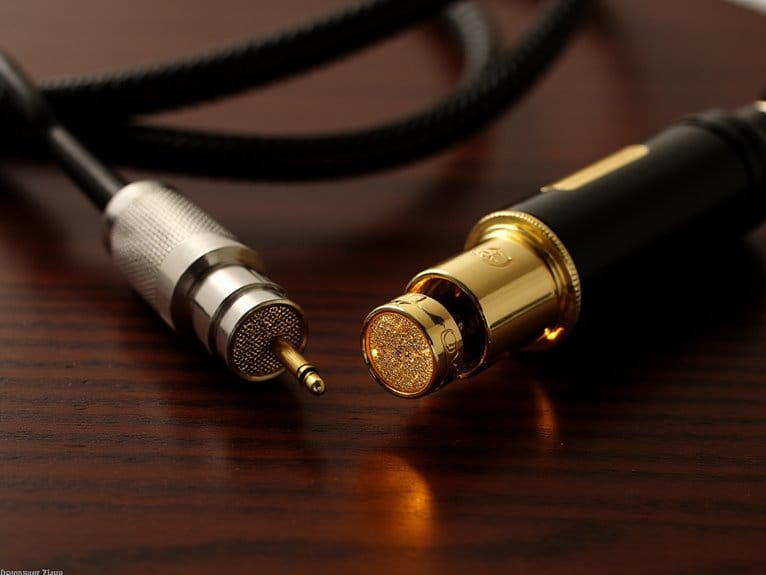
When impedance mismatches occur in your audio chain, you’ll often notice them through subtle symptoms that can masquerade as other technical issues, making proper diagnosis essential for maintaining professional sound quality. The most telling sign is signal loss—you might experience up to 6 dB attenuation when connecting a 600-ohm microphone to a poorly matched input, compared to just 0.5 dB with proper matching.
During impedance troubleshooting, I’ve found that frequency response alterations often reveal themselves as unwanted coloration in specific ranges, while increased noise floors indicate loading problems beyond your microphone’s design parameters.
Your best solutions involve careful transformer selection with appropriate turns ratios, choosing preamps with input impedances at least 10 times higher than your microphone’s output impedance, and employing passive attenuators when necessary.
Frequently Asked Questions
Can I Use a High Impedance Microphone With My Smartphone or Tablet?
You can’t directly connect a high impedance microphone to your smartphone without encountering significant high impedance compatibility issues that’ll compromise your smartphone audio quality.
I’ve found that smartphones expect 600-800 ohm inputs, while high impedance mics output several thousand ohms, creating mismatched signals.
You’ll need an impedance matching transformer, preamp, or specialized adapter to bridge this gap and achieve proper audio levels.
Do Wireless Microphone Systems Have Different Impedance Considerations Than Wired Ones?
You’ll find wireless microphone systems actually offer wireless advantages like simplified setup while maintaining identical impedance specifications to wired mics, typically 150-600Ω output.
The receiver’s buffered output stage guarantees signal stability regardless of cable length to your preamp.
I’ve noticed most professional wireless systems transparently interface with standard mic inputs, so you’ll apply the same 5-10x impedance bridging rule without additional considerations.
Will Changing My Microphone Cable Affect the Overall Impedance of My Setup?
Changing your microphone cable won’t greatly alter your mic’s output impedance, but cable quality definitely affects your signal path’s performance.
I’ve found that higher-capacitance cables create low-pass filtering effects, especially over long runs, while different connector types can introduce resistance variations.
Your cable basically becomes part of the transmission medium, influencing frequency response and noise characteristics rather than fundamentally changing impedance measurements.
How Does Temperature and Humidity Affect Microphone Impedance Over Time?
Temperature fluctuations and humidity levels gradually affect your microphone’s impedance through material degradation, particularly the electrical insulation that maintains stable resistance values.
While I’ve observed that modern microphones resist short-term environmental changes quite well, prolonged exposure to extreme conditions, excessive moisture, or thermal cycling can alter internal components over months or years.
This requires periodic calibration to guarantee your setup maintains ideal signal integrity and performance consistency.
Can I Damage My Equipment by Using Mismatched Impedance Microphones and Preamps?
You won’t damage your equipment through impedance mismatch consequences, as I’ve learned from years of testing various combinations.
The mismatch affects signal transfer characteristics, not mechanical or thermal stress that causes hardware failure. Your equipment protection remains intact since microphone outputs and preamp inputs handle these electrical variations without degradation.
However, you’ll experience audio quality issues like frequency response changes, signal weakness, or distortion requiring compensatory gain adjustments.
On a final note
You’ve now got the essential knowledge to tackle impedance matching confidently, though I’ll admit the technical details can feel overwhelming at first. Remember that most modern equipment handles basic matching automatically, but understanding these principles helps you troubleshoot issues and make informed purchasing decisions. When you’re connecting mics to preamps, you’ll achieve cleaner signals and avoid common problems by applying what you’ve learned here.

